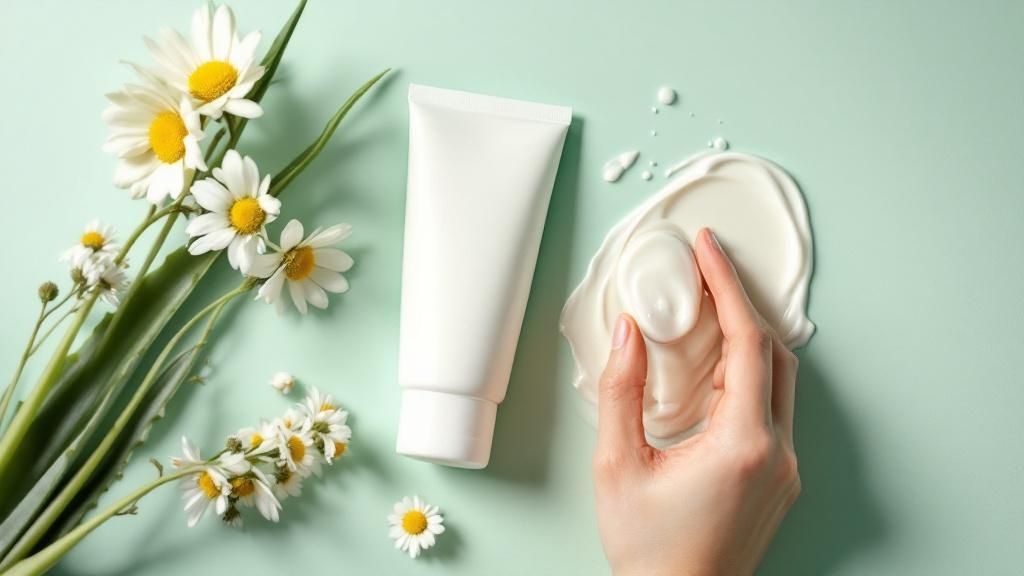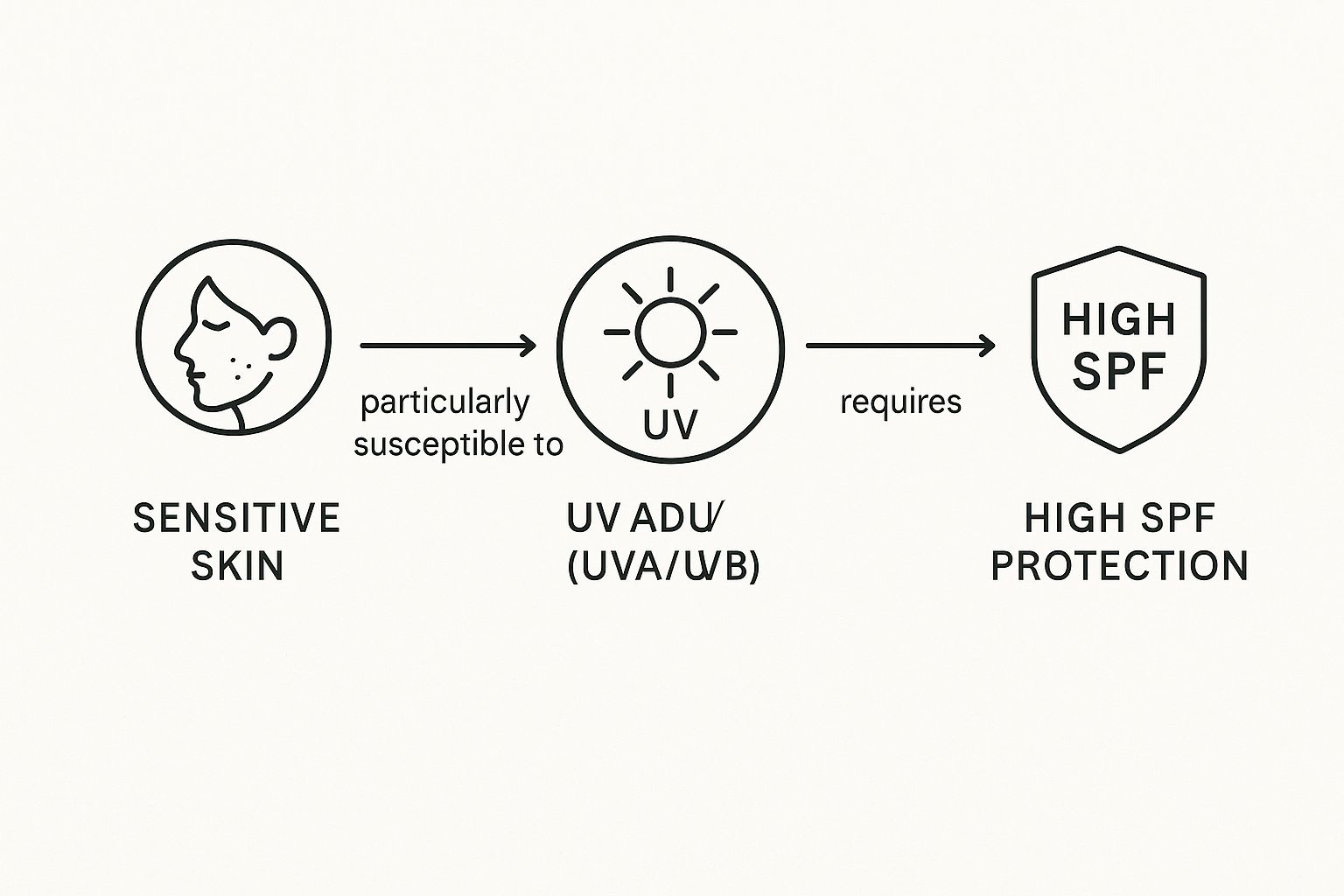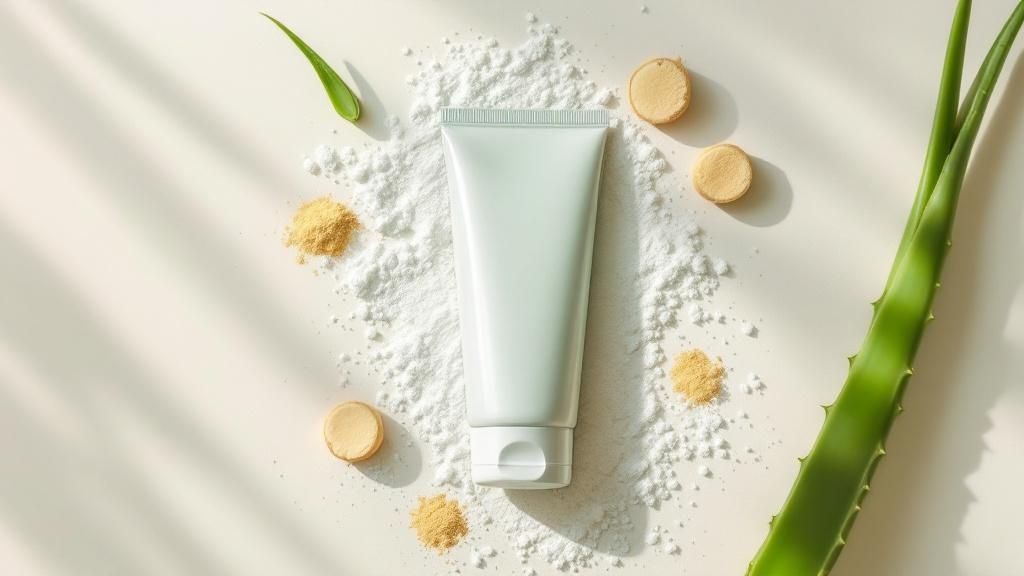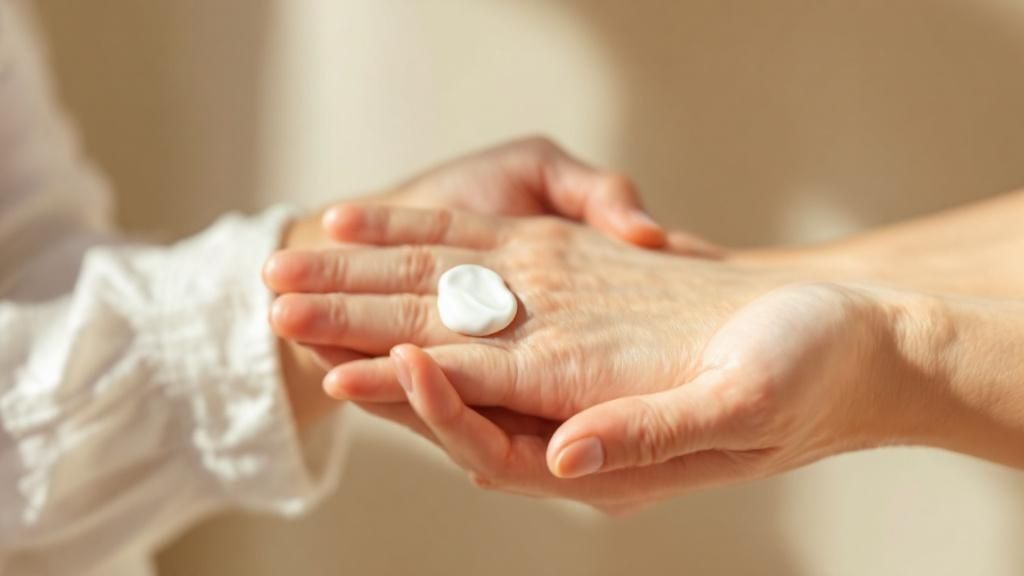
When you have sensitive skin, finding the right sunscreen can feel less like a shopping trip and more like a high-stakes mission. Get it wrong, and you're left with stinging, redness, or an unexpected breakout. But get it right? You'll have a calm, protected complexion that feels as good as it looks.
For most people I work with, the best choice almost always comes down to a mineral-based formula. These sunscreens, which use ingredients like zinc oxide or titanium dioxide, create a gentle, physical barrier on your skin. They're far less likely to cause irritation compared to their chemical counterparts. A prime example is the BARB N.P. Mineral Defense Sunscreen, which is specifically designed to provide robust protection without triggering sensitivity.
Your Guide to Calm and Protected Skin
Navigating the world of sun protection when your skin reacts to nearly everything can feel overwhelming. The wrong formula can turn a vital health habit into something you dread. But finding a sunscreen that both calms and protects is entirely achievable once you know exactly what to look for.
This guide is your roadmap. We're skipping the generic advice to focus on the specifics that truly matter for reactive skin. My goal is to give you the knowledge to confidently pick a product that becomes a seamless, comfortable part of your daily routine—not a source of stress.
Why Mineral Sunscreens Are a Safer Bet
The mineral versus chemical sunscreen debate is a big one, but for sensitive skin, the answer is pretty clear.
Think of mineral sunscreens (with zinc oxide and titanium dioxide) as a protective shield. They physically sit on top of your skin and block UV rays before they can penetrate. It's a gentle, straightforward approach.
Chemical sunscreens, on the other hand, work by absorbing UV radiation and converting it into heat within the skin. This chemical reaction is often what triggers redness, stinging, and irritation in sensitive individuals. It's this core difference that makes mineral formulas the gold standard for easily upset skin.
And once your skin is calm, you can focus on building a routine that creates a healthy glow. You can learn more about this in my guide on how to achieve a radiant complexion with Epicutis.
To make it even clearer, here’s a quick comparison.
Quick Guide Mineral vs Chemical Sunscreen for Sensitive Skin
This table breaks down why I almost always point my clients with sensitive skin toward mineral formulas.
| Feature | Mineral Sunscreen (Recommended) | Chemical Sunscreen (Use with Caution) |
|---|---|---|
| How It Works | Sits on top of skin, physically blocking UV rays. | Absorbs into skin, converting UV rays to heat. |
| Active Ingredients | Zinc Oxide, Titanium Dioxide. | Oxybenzone, Avobenzone, Octinoxate, etc. |
| Irritation Risk | Very low. Ingredients are gentle and well-tolerated. | Higher. Chemical reaction can cause stinging or redness. |
| Protection Speed | Works immediately upon application. | Needs about 20 minutes to become effective. |
| Best For | Sensitive, acne-prone, rosacea, and post-procedure skin. | Resilient skin types with no history of sensitivity. |
In short, mineral sunscreens offer a gentler path to protection without the potential for unwanted reactions.
What You Will Learn in This Guide
This guide is designed to help you decode confusing product labels and finally understand your skin’s unique needs. We’ll explore:
- Key Triggers: Pinpointing what ingredients and formulas are causing your skin to react.
- Label Literacy: How to read ingredient lists and see past clever marketing claims.
- Application Techniques: The right way to apply sunscreen for full, non-irritating coverage.
You're not alone in seeking out gentle, effective skincare. The demand has grown so much that the sensitive skin care market is now valued at approximately $48.42 billion globally and is expected to keep expanding. This shift shows a much wider understanding of skin health—and the need for specialized products that truly work.
Understanding Why Your Skin Reacts to Sunscreen
If you’ve ever felt that dreaded stinging, itching, or redness after applying sunscreen, you know how frustrating it can be. It’s not in your head—it’s your skin sending a clear signal that something in the formula just isn't right.
To find a sunscreen that works with your sensitive skin instead of against it, we first need to understand the root cause of these reactions.
It almost always comes down to a compromised skin barrier. Think of your skin's outer layer like a brick wall. The skin cells are the bricks, and the lipids (like ceramides) are the mortar holding everything together. When that mortar is weak or has gaps, your wall is no longer secure.

This visual shows exactly why high-SPF protection is so critical for sensitive skin. With a weakened defense system, UV rays can cause even more irritation, making a protective shield essential.
Irritant vs. Allergic Reactions
When that barrier is compromised, potential irritants in a sunscreen can slip through the cracks and trigger inflammation. This is why an ingredient that doesn't bother your friend might cause a major flare-up for you. There are two main types of reactions to watch out for:
- Irritant Contact Dermatitis: This is the most common one. It’s an immediate, direct reaction where an ingredient literally irritates the surface of your skin. You'll feel it as stinging, burning, or redness right away. Chemical filters, fragrances, and some preservatives are often the culprits.
- Allergic Contact Dermatitis: This is a true immune response. It’s not immediate—it can take hours or even a couple of days to show up as an itchy, red rash. Your body has "remembered" an ingredient from past exposure and is now reacting to it. Certain chemical UV filters, like oxybenzone, are known triggers for this.
An irritant reaction is your skin shouting, "This is hurting me right now!" An allergic reaction is your immune system whispering, "I've seen this before, and I don't like it."
Knowing the difference is a game-changer. An irritant reaction suggests the formula is just too harsh for your barrier. But an allergic reaction points to a specific ingredient you'll need to avoid in all products moving forward.
Pinpointing Your Triggers
For sensitive skin, the goal is simple: find products that support your skin barrier, not attack it. This is precisely why mineral sunscreens are so often the holy grail for reactive skin.
Formulas with zinc oxide or titanium dioxide sit on top of the skin, forming a physical shield. They don't need to be absorbed to work, which dramatically lowers the risk of a reaction. Zinc oxide, in particular, is known for its soothing properties, making it a fantastic choice for calming already-irritated skin. The BARB N.P. Mineral Defense Sunscreen relies on zinc oxide for this very reason, providing gentle yet effective protection.
By understanding that your sensitivity likely stems from a weakened barrier and specific ingredient triggers, you can finally make smart, informed choices. When you reach for gentle, fragrance-free mineral formulas, you're not just protecting your skin from the sun—you're giving it the calm, reliable care it needs to stay healthy.
How to Read Sunscreen Labels Like an Expert

Walking down the sunscreen aisle can feel like trying to crack a secret code. Between the acronyms, numbers, and long ingredient lists, it’s tempting to just grab the first bottle you see and hope for the best.
But when you have sensitive skin, knowing how to read that label is the single most important step you can take. It’s your best defense against irritation and your ticket to finding a product that truly protects and calms your skin.
The good news? You only need to spot a few key things to shop with confidence. Think of it as a simple checklist that instantly filters out the bad stuff, leaving you with only the best options on the shelf.
The Non-Negotiables for Sensitive Skin
Before you even think about bonus ingredients, there are a few absolute must-haves for any sunscreen you consider. These are the core requirements that guarantee you’re getting safe, effective protection without risking a reaction.
Start by scanning the front of the bottle for these three essentials:
- Broad-Spectrum Protection: This is critical. It’s your confirmation that the formula protects against both UVA rays (the aging rays) and UVB rays (the burning rays). Without it, you're only getting half the protection you need.
- SPF 30 or Higher: The Sun Protection Factor (SPF) tells you how well it blocks UVB rays. SPF 30 blocks about 97% of UVB, while SPF 50 blocks roughly 98%. For daily defense, SPF 30 is the absolute minimum.
- Mineral Active Ingredients: Now, flip the bottle over to the "Active Ingredients" list. For reactive skin, you want to see Zinc Oxide or Titanium Dioxide right at the top. These are the gentle giants of sun protection—physical blockers that sit on top of your skin.
Think of these three as your entry ticket. If a sunscreen doesn't tick all three boxes—broad-spectrum, at least SPF 30, and a mineral formula—it's not the right fit for sensitive skin. You can put it back and move on.
Decoding Soothing and Safe Language
Once you’ve got the basics covered, a few other phrases signal that a product was truly made with sensitive skin in mind. Labels like "hypoallergenic" and "fragrance-free" are green lights. They tell you the brand has gone the extra mile to remove common triggers for redness and irritation.
You can learn more about finding products that combine gentle protection with hydration in our guide to choosing the best face cream with SPF.
For an extra dose of skin-calming goodness, look for these beneficial additions in the inactive ingredient list:
- Niacinamide: A superstar for reducing redness and inflammation.
- Ceramides: Helps rebuild and strengthen your delicate skin barrier.
- Hyaluronic Acid: Delivers lightweight hydration without feeling heavy or greasy.
The BARB N.P. Mineral Defense Sunscreen, for example, was built on these exact principles. It uses a clean, mineral-based formula to give you powerful protection without any of the common irritants. It's the kind of smart, targeted defense your sensitive skin deserves.
Our Top Sunscreen Picks for Sensitive Skin
Okay, now that you know what to look for on a label, it’s time to find your perfect match. I know—sifting through endless options can feel overwhelming. That’s why I’ve put together a short list of my top recommendations, all chosen for their gentle, effective formulas that truly respect sensitive skin.
My premier choice is the BARB N.P. Mineral Defense Sunscreen. It’s the perfect example of everything sensitive skin craves: a zinc oxide-based formula that gives you broad-spectrum protection without a hint of irritation. It’s also beautifully lightweight and comfortable, so you won’t get that heavy, greasy feeling that makes daily application a chore. We even added soothing botanicals to help calm redness and keep your skin barrier happy.
For Oily and Acne-Prone Skin
If your sensitive skin also deals with excess oil and breakouts, the last thing you want is a formula that clogs pores or adds shine. A mattifying mineral sunscreen is your absolute best friend here. Keep an eye out for products labeled "oil-free" and "non-comedogenic"—these are your clues that you're getting a lightweight feel that will keep your complexion clear and balanced all day. The lightweight nature of the BARB N.P. Mineral Defense Sunscreen makes it a suitable option even for those concerned about a greasy finish.
For Dry and Dehydrated Skin
On the flip side, if your skin leans dry and flaky, a purely mattifying formula can feel tight and just plain uncomfortable. Your ideal sunscreen should pull double-duty as a hydrator. The best options are enriched with ingredients like hyaluronic acid and ceramides. These powerhouses help lock in moisture and reinforce your skin’s barrier, leaving it feeling soft and supple, not stripped. You can learn more about these kinds of protective formulas in our guide on the SkinCeuticals Daily Soothing UV Defense Sunscreen.
The best sunscreen for sensitive skin isn't just about what it lacks—like fragrance and chemical filters. It's also about what it adds—like soothing botanicals, barrier-repairing ceramides, or lightweight hydration.
For an Even, Glowing Complexion
Let’s be honest: mineral sunscreens can sometimes leave a subtle white cast, especially on deeper skin tones. This is where a tinted mineral sunscreen comes in to save the day. These formulas use iron oxides—which are safe, natural pigments—to add a sheer wash of color that blends right into your skin. Not only does this neutralize any whiteness from the zinc oxide, but it also helps even out your skin tone, blur minor imperfections, and give you a healthy, natural glow.
For Active Days and Water Resistance
When you’re swimming, hiking, or just sweating it out, you need sun protection that can keep up. For those days, a water-resistant mineral sunscreen is non-negotiable. These formulas are specifically designed to stick to the skin longer, usually for 40 or 80 minutes of water exposure. Just remember that no sunscreen is truly "waterproof." You have to be diligent about reapplying after toweling off or after the time is up to stay protected.
Applying Sunscreen for Maximum Protection and Comfort

You’ve done the hard work and found the perfect sunscreen for your sensitive skin. That’s a huge win, but the job isn't quite finished. Even the most elegant, gentle formula won't do you any good if it isn't applied correctly. Nailing the application process is how you get the full, irritation-free protection promised on the bottle.
Think of your sunscreen as the final, non-negotiable shield in your morning skincare routine. Let your serums and moisturizer sink in completely, then it’s time for sun protection. This gives the sunscreen a clean, prepped canvas to adhere to, creating a far more even and effective barrier against UV rays.
It's no surprise that the demand for these gentle, effective products is exploding. The sensitive skin sunscreen market is on track to be worth around $14.54 billion by 2025 and is only expected to keep climbing. This isn't just a trend; it's a massive consumer shift toward prioritizing skin health with smarter ingredients. You can read more about this market growth on datainsightsmarket.com.
How Much Sunscreen You Really Need to Use
This is where most people go wrong. Skimping on your sunscreen is one of the biggest mistakes you can make—it drastically reduces its protective power and leaves your skin vulnerable to damage.
An easy guideline to remember is the "two-finger rule." Just squeeze a line of sunscreen down the length of your index and middle fingers. That’s the perfect amount to cover your face and neck thoroughly. For your body, think in terms of a full shot glass.
The SPF number on the bottle is based on lab tests where a much thicker layer is used than what most of us apply at home. Using the right amount isn't just a suggestion; it’s the only way to get the protection you're paying for.
The Reapplication Rule and Why Removal Matters
Sunscreen isn't a "set it and forget it" kind of product. Its effectiveness breaks down over time, especially when you're out in the sun or sweating. To stay fully protected, you have to reapply it every two hours—or even more often if you’ve been swimming or exercising.
At the end of the day, taking it off properly is just as important as putting it on. Mineral sunscreens sit on top of the skin, and if you don't wash them away completely, they can clog pores and lead to breakouts.
Here’s the best way to do it:
- Step 1: The Oil Cleanse: Start with an oil-based cleanser or a cleansing balm. This is the secret to melting away stubborn sunscreen, makeup, and daily grime without having to scrub your skin raw.
- Step 2: The Gentle Cleanse: Follow up with your favorite mild, water-based cleanser. This washes away any remaining residue, leaving your skin perfectly clean and prepped for your nighttime products. This "double-cleanse" method ensures nothing is left behind to cause trouble overnight.
Your Sunscreen Questions, Answered
Even when you find the perfect sunscreen, a few questions always seem to pop up. Let's clear up some of the most common ones so you can feel completely confident about protecting your sensitive skin.
Can I Use My Facial Sunscreen on My Body?
Yes, absolutely. A sunscreen formulated for delicate facial skin is perfectly safe and effective for your body. The main difference you'll notice is the price tag and the size of the bottle.
For larger areas like your arms and legs, it's often more economical to find a body-specific mineral sunscreen that's also fragrance-free. Just make sure the same core principles apply: look for broad-spectrum SPF 30+ and double-check the label for gentle, non-irritating ingredients.
What's the Real Difference Between "Unscented" and "Fragrance-Free"?
This is a huge one, especially for reactive skin. "Fragrance-free" is exactly what it sounds like—no fragrances, synthetic or natural, have been added to the product. It’s the gold standard for sensitive skin.
"Unscented," on the other hand, can be tricky. It often means a masking fragrance was added to neutralize the natural smell of the other ingredients. To play it safe and minimize your risk of a reaction, always look for products explicitly labeled "fragrance-free."
Choosing "fragrance-free" is a proactive step to avoid potential irritants. "Unscented" can sometimes hide them in plain sight. It’s a small detail that makes a world of difference for easily upset skin.
How Do I Avoid That White Cast From Mineral Sunscreen?
That chalky finish is caused by the mineral filters themselves—zinc oxide and titanium dioxide. The good news is that modern formulas have come a long way, often using micronized particles that blend much more easily.
But the best solution by far? Look for tinted mineral sunscreens. These formulas use natural iron oxides to add a sheer, skin-toned color that cancels out any potential whiteness. Another pro tip is to apply your sunscreen in thin layers, letting each one set for a moment before adding the next. This helps it absorb seamlessly.
At BARB N.P., we believe educated choices lead to the best results. Explore our curated collection of medical-grade skincare to find gentle, effective products that support your skin's health and radiance.

